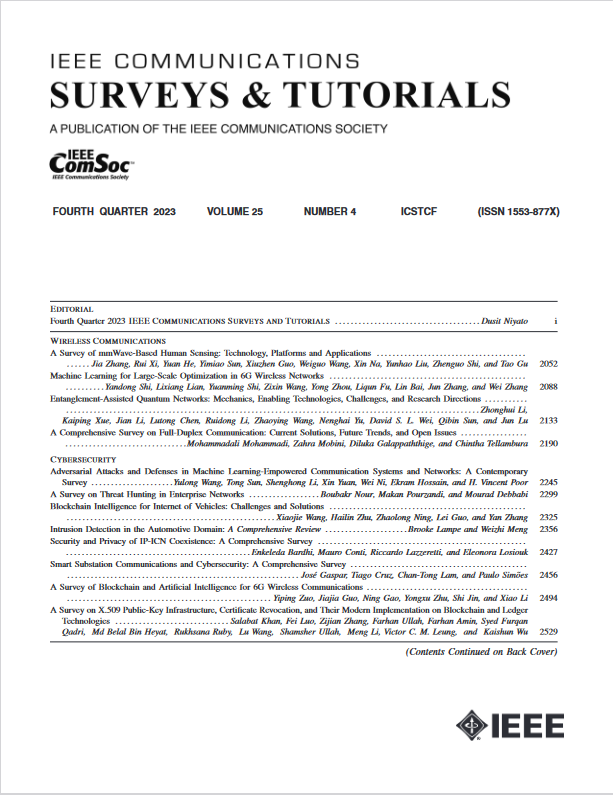A Human-Centric Metaverse Enabled by Brain-Computer Interface: A Survey
IF 34.4
1区 计算机科学
Q1 COMPUTER SCIENCE, INFORMATION SYSTEMS
引用次数: 0
Abstract
The growing interest in the Metaverse has generated momentum for members of academia and industry to innovate toward realizing the Metaverse world. The Metaverse is a unique, continuous, and shared virtual world where humans embody a digital form within an online platform. Through a digital avatar, Metaverse users should have a perceptual presence within the environment and can interact and control the virtual world around them. Thus, a human-centric design is a crucial element of the Metaverse. The human users are not only the central entity but also the source of multi-sensory data that can be used to enrich the Metaverse ecosystem. In this survey, we study the potential applications of Brain-Computer Interface (BCI) technologies that can enhance the experience of Metaverse users. By directly communicating with the human brain, the most complex organ in the human body, BCI technologies hold the potential for the most intuitive human-machine system operating at the speed of thought. BCI technologies can enable various innovative applications for the Metaverse through this neural pathway, such as user cognitive state monitoring, digital avatar control, virtual interactions, and imagined speech communications. This survey first outlines the fundamental background of the Metaverse and BCI technologies. We then discuss the current challenges of the Metaverse that can potentially be addressed by BCI, such as motion sickness when users experience virtual environments or the negative emotional states of users in immersive virtual applications. After that, we propose and discuss a new research direction called Human Digital Twin, in which digital twins can create an intelligent and interactable avatar from the user’s brain signals. We also present the challenges and potential solutions in synchronizing and communicating between virtual and physical entities in the Metaverse. Finally, we highlight the challenges, open issues, and future research directions for BCI-enabled Metaverse systems.通过脑机接口实现以人为本的元宇宙:一项调查
人们对 Metaverse 的兴趣与日俱增,促使学术界和产业界人士为实现 Metaverse 世界进行创新。Metaverse 是一个独特、连续和共享的虚拟世界,在这个世界里,人类在一个在线平台上以数字形式体现。通过数字化身,Metaverse 用户应在环境中具有感知存在感,并能与周围的虚拟世界进行交互和控制。因此,以人为本的设计是 Metaverse 的关键要素。人类用户不仅是中心实体,也是可用于丰富元宇宙生态系统的多感官数据的来源。在这项调查中,我们研究了脑机接口(BCI)技术的潜在应用,这些技术可以增强元宇宙用户的体验。人脑是人体最复杂的器官,通过与人脑直接交流,BCI 技术有望成为以思维速度运行的最直观的人机系统。通过这一神经通路,BCI 技术可为 Metaverse 带来各种创新应用,如用户认知状态监测、数字化身控制、虚拟互动和想象语音通信。本研究首先概述了 Metaverse 和 BCI 技术的基本背景。然后,我们讨论了目前 Metaverse 面临的挑战,这些挑战有可能通过 BCI 得到解决,例如用户在体验虚拟环境时的晕动症或用户在沉浸式虚拟应用中的负面情绪状态。之后,我们提出并讨论了一个新的研究方向,即 "人类数字双胞胎"(Human Digital Twin),其中数字双胞胎可以通过用户的大脑信号创建一个智能和可交互的化身。我们还介绍了在 Metaverse 中实现虚拟实体与物理实体同步和通信所面临的挑战和潜在解决方案。最后,我们强调了支持 BCI 的 Metaverse 系统所面临的挑战、有待解决的问题以及未来的研究方向。
本文章由计算机程序翻译,如有差异,请以英文原文为准。
求助全文
约1分钟内获得全文
求助全文
来源期刊

IEEE Communications Surveys and Tutorials
COMPUTER SCIENCE, INFORMATION SYSTEMS-TELECOMMUNICATIONS
CiteScore
80.20
自引率
2.50%
发文量
84
审稿时长
6 months
期刊介绍:
IEEE Communications Surveys & Tutorials is an online journal published by the IEEE Communications Society for tutorials and surveys covering all aspects of the communications field. Telecommunications technology is progressing at a rapid pace, and the IEEE Communications Society is committed to providing researchers and other professionals the information and tools to stay abreast. IEEE Communications Surveys and Tutorials focuses on integrating and adding understanding to the existing literature on communications, putting results in context. Whether searching for in-depth information about a familiar area or an introduction into a new area, IEEE Communications Surveys & Tutorials aims to be the premier source of peer-reviewed, comprehensive tutorials and surveys, and pointers to further sources. IEEE Communications Surveys & Tutorials publishes only articles exclusively written for IEEE Communications Surveys & Tutorials and go through a rigorous review process before their publication in the quarterly issues.
A tutorial article in the IEEE Communications Surveys & Tutorials should be designed to help the reader to become familiar with and learn something specific about a chosen topic. In contrast, the term survey, as applied here, is defined to mean a survey of the literature. A survey article in IEEE Communications Surveys & Tutorials should provide a comprehensive review of developments in a selected area, covering its development from its inception to its current state and beyond, and illustrating its development through liberal citations from the literature. Both tutorials and surveys should be tutorial in nature and should be written in a style comprehensible to readers outside the specialty of the article.
 求助内容:
求助内容: 应助结果提醒方式:
应助结果提醒方式:


